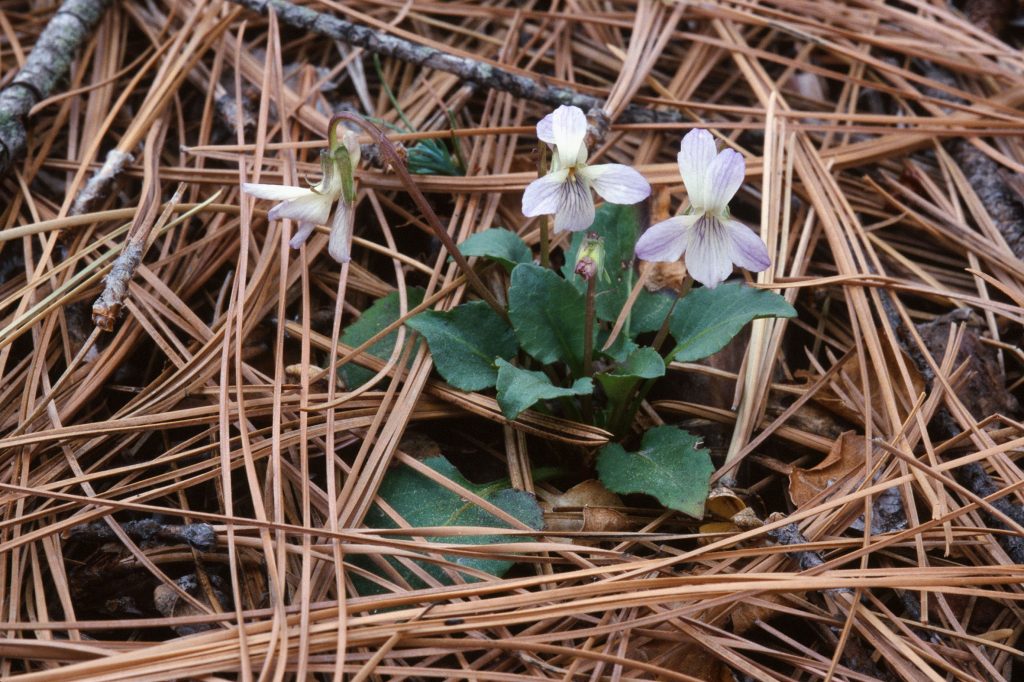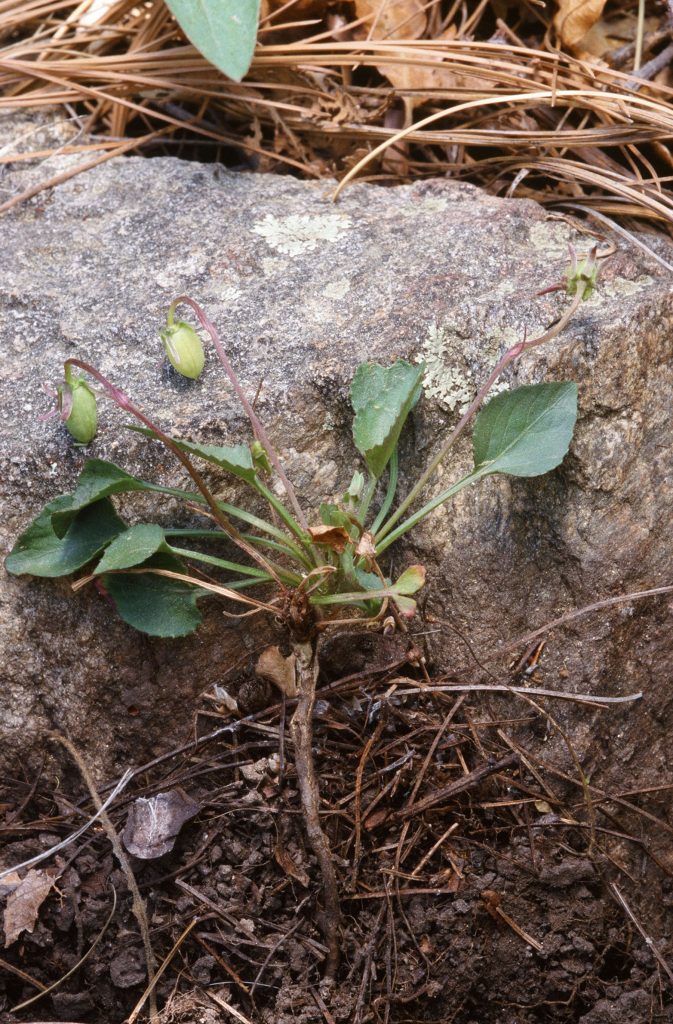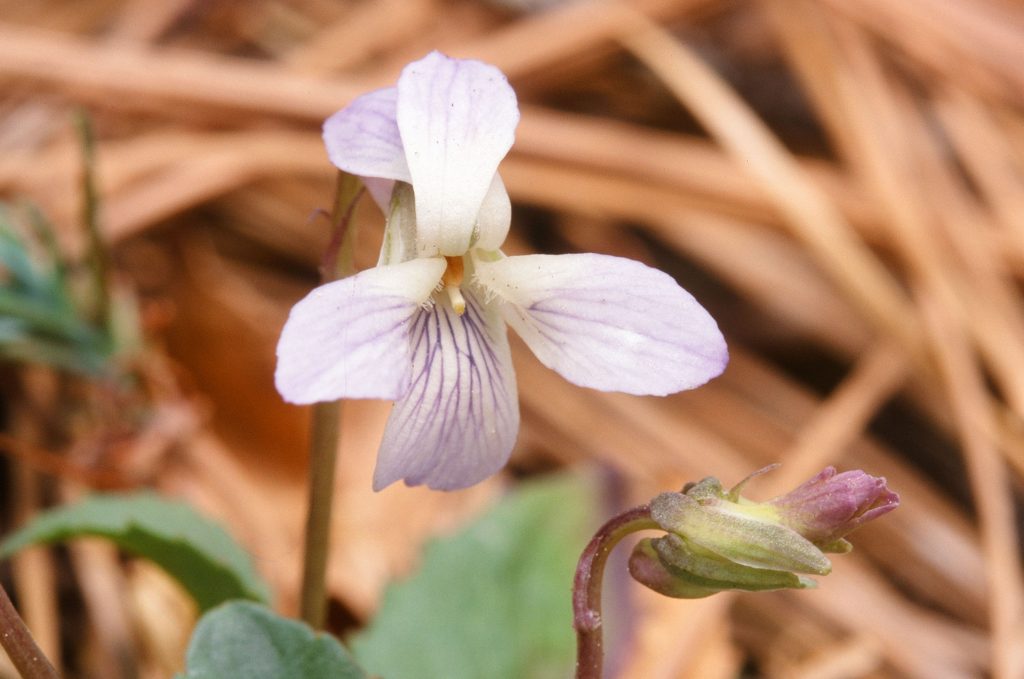Viola umbraticola Kunth (or HBK.) var glaberrima Becker
Description. Illustrations: 3 photographs of Viola umbraticola and 1 drawing.
A xerophytic member of subsection Rostratae, similar in appearance to Viola adunca (with which it is often confused) except for its lack of stems. The plants are small with blue flowers scarcely above the leaves, partly obscured and presumably protected, by a ground covering layer of pine needles. It is endemic to the mountains of northern Mexico and Southern Arizona where there is no or very little precipitation after spring snow melt until July. The plants are scattered on sloping hillsides in the shade of open pine forests at altitudes from 5200 to 8100 feet. The xerophytic properties of this species are its compactness, its long wiry taproot and its small leathery leaves. Plants grow very slowly in the harsh dry habitat taking several years to reach flowering size. It does not die down in summer.

The plants present in Arizona belong to variety glaberrima with leaves obscurely purberulent to glabrous, contrasting with variety umbraticola, found only in Mexico, that is typically densely pubescent with short hairs. Characteristics shared with V. adunca are the shape of, and the projections on, the style head, the laciniate adnate stipules, the ovate shaped leaves with short cuneate to truncate leaf bases and its slightly hooked pale spur from 3 to 5 mm long. V. umbraticola is easily separated from V. nephrophylla, a similarly stemless blue-flowering violet present in Arizona by leaf shape, length of peduncles at flowering and habitat. The latter species has long lobes forming a deep indentation at the base of the wide leaf while V. umbraticola has a shallow indentation (short lobes) or no indentation (truncate or slightly cuneate leaf bases). V. nephrophylla prefers to grow in wetter locations in alkaline soils and carries its flowers high above the leaves.
Plants of V. umbraticola grow to about 10 cm tall. Older plants often have several crowns growing from a branching vertical rootstock. The fibrous upper 1-2 cm of this rootstock are densely covered by the remains of old petiole bases and stipules persistent for many years, below which is a long, tough taproot and an extensive wiry lateral root system.

The petioles are glabrous, up to 6 cm long but usually shorter. Stipules to 1.1 cm long, adnate to the base of the petiole for a quarter to half of their length. The stipule margins are deeply laciniate and shortly ciliate. The leaves are leathery; leaf blades ovate, leaf bases shallowly cordate to truncate, the tip pointed, 1.0-3.5 mm long, to 2.5 cm wide. Some plants are completely glabrous while others have scattered very short stiff hairs on the upper leaf midrib and veins, and on the paler lower lamina but not veins or mid-rib. The leaf margins are glabrous, with relatively large prominent teeth, the margins decurrent for the length of the petiole. Older leaves and persistent dead leaves from the previous season are lying on the ground under the new season growth.
Flower peduncles are short, purple, pubescent and up to 8 cm in length. The bracteoles appear barely attached near the top of the peduncle, not wrapping around the peduncle and not opposite, 0.5 mm long. They are very narrow and tapering with 3-4 short fimbriae at the base. The sepals are glabrous, gradually tapering to a large terminal gland, 4-8 mm long including the 1 mm long appendage. Flowers are approximately 1.6 cm long and wide. The flower colour varies between plants, from deep blue-violet through to pale blue and occasionally white, the colour deepest towards the outer edge of the petals, with white on the base of all five petals and a touch of pale green in the centre of the throat. The petals are narrow; the two top petals fold backwards as the flower ages, sometimes crossing each other (as is common in V. adunca var. minor), the laterals with a light beard of narrow straight hairs, the lowest petal with purple guidelines, 0-1.6 cm long including the spur. On the back and sides of the style there are very short projections, typical of species in subsection Rostratae. The spur is slightly hooked at the end, 3-5 mm long x 2.0 mm wide, bilobed at the end, a characteristic common to many European species of the Rostratae (V. canina, V. caspia, V. reichenbachiana and V. riviniana) but not common in its North American representatives. Flowering period April to July.

As the seed capsules grow, their erect peduncles elongate to twice their length at flowering. The pod peduncles, sepals and appendages are all purple; pods are pale green, glabrous, obovate, triangular in section and 4-11 mm long; seeds are 2.6 mm long x 1.7 mm diameter including the colourless elaiosome.

The habitat of V. umbraticola is in the shade of sparce stands of Pondersa pines (Pseudotsuga menziesii), sometimes with Juniper (Juniperus deppeana) and oak (Quercus arizonica), where it grows to the upper tree-line. The dry sites are covered in dense pine duff, often under the protection of shrubs, rocks or fallen trees. The sandy soil is derived from soft granite and quartzite rendered acidic by the slow breakdown of pine needles. This violet species usually occurs on southeast facing slopes where it is seen as scattered plants, however it has been reported as abundant on one western exposure. It does not grow in areas burnt by forest fires that are common in early summer.
V. umbraticola is endemic to the mountains of northern Mexico (Sonora and Chihuahua states) and Southern Arizona around Tucson (Chiricahua and Huachuca Mountains in Cochise County, Santa Catalina Mountains in Pima County, the Santa Rita Mountains in Santa Cruz County, and on the Humphreys & Kendrick Peaks of Coconino County).
Taxonomy & Nomenclature:
Viola umbraticola Kunth (H.K.B.) Nov. Gen. Sp. [H.B.K.] 5: 370-371. 1821 [1823].
Viola umbraticola H.K.B. var. glaberrima W. Becker, Repert. Spec. Nov. Regni Veg. 20: 7. 1924.
This violet was previously classified in subsection Umbraticolae, however Ballard (1999) has written that ‘current data would seem to argue for a single and variable infrasectional group, the Rostratae, without subdivisions.’
Chromosome number and ploidy level are unknown.